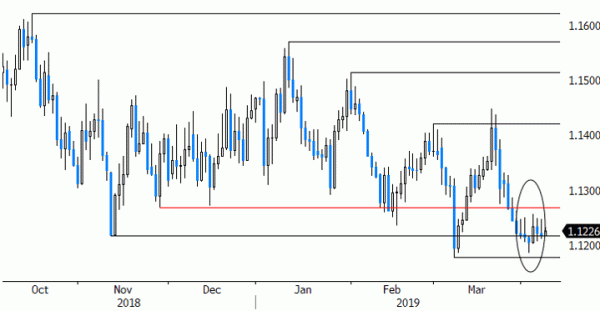Rates: US 10-yr yield fails to retake 2.54%
The US 10-yr yield failed to regain previous support (2.54%) last week. Mixed March payrolls caused return action lower. This week’s eco calendar is fairly thin. Wednesday’s ECB meeting is the main event, but we expect the central bank to keep low following huge decisions in March. Core bonds could regain advantage in thin trading.
Currencies: USD remains resilient despite soft US wage data
Mediocre US wage data on Friday suggested that the Fed can keep a soft tone in the foreseeable future. However, the dollar didn’t lose any further ground. At the same time, the EUR/USD 1.1177/87 support still survives. There is no clear USD trend visible at the start of the new week. More technical trading around current levels might be on the cards
The Sunrise Headlines
- US equity markets edged closer toward their all-time highs as all major indices gained ground again on Friday. Asian equities are mixed this morning with Chinese bourses underperforming after returning from holiday on Friday.
- UK PM May hopes to continue cross-party talks with opposition leader Corbyn, after talks appeared to be stuck yesterday. May urgently needs a sign of progress as she travels to Brussels on Wednesday seeking a new Brexit delay.
- US top economic advisor Kudlow said the US and China are ‘closer and closer’ to a trade deal and added that negotiations will continue this week over the phone. Chinese media said that the remaining issues are all ‘hard nuts to crack’.
- EU trade commissioner Malmström voiced frustration over China’s trade policies, sharing US frustration about China’s model of subsides state-owned companies that expand internationally. Both parties meet tomorrow. (FT)
- Libya’s government is organizing military resistance against Haftar, a military officer who supports a shadow government, whose army is approaching Tripoli. The disruptions in the OPEC member pushes the oil price (Brent) above $70 p/b.
- Local media report that the Italian government will use a contingency fund of €2 bn to ensure its structural deficit target is met after lower economic forecasts put its 2019 budget under pressure. The fund has the EU’s approval.
- Today’s eco calendar is close to empty. The US prints a final reading of durable goods orders (Feb). The Sentix Investor confidence (Apr) gets published for the EMU. The IMF and the World Bank hold their annual spring meeting this week.
Currencies: USD Remains Resilient Despite Soft US Wage Data
USD stays resilient despite soft US wage data
On Friday, the euro initially gained a few ticks on a positive risk sentiment and better German production data. The pair settled in a tight range in the 1.1230 area, awaiting the US payrolls. The US economy created more jobs than expected in March (196 000) and the unemployment rate stayed near the cycle low (3.8%), but wage growth disappointed (0.1% M/M – 3.2 % Y/Y). These poor wage statistics suggested that the Fed shouldn’t change its wait-and-see stance anytime soon. US yields and the dollar briefly declined a few ticks up-on the release, but the dollar soon found its composure. EUR/USD even closed the day marginally lower at 1.1216. The dollar also gained a few ticks against the yen (111.73 vs 111.66).
Asian equities are showing a mixed/cautious picture this morning even as US equity bourses are coming ever closer to the all-time peak levels. The dollar is trading with a tentative negative bias. USD/JPY hit an intraday air pocket as Japanese equities are facing some, albeit modest headwinds. EUR/USD again rebounds off the low 1.12 support area.
Later today, there are only second tier data in EMU. Euro traders might keep an eye at the German foreign trade data as the external sector was heavily weighing on growth of late. US factory orders are probably also only of intraday significance, at best. Brexit and the US-China trade talks remain wildcards for trading. We were a bit surprised by Friday’s, albeit modest, USD gain. If US wage (or price) data remains soft, investor anticipation on a potential Fed rate cut might stay alive. In this context, further sustained USD gains are not that evident. Last week, EUR/USD came close to the 1.1177/87 support, but a real test/break didn’t occur. For that to happen, unexpected negative EMU news or surprisingly strong US data are probably needed. Recent data evidence doesn’t support this scenario. We keep the view that a sustained EUR/USD decline isn’t that evident as we don’t expect the Fed to leave its wait-and-see bias anytime soon.
In technical trade on Friday, sterling drifted lower into the weekend as the negotiations between the conservative Party and labour didn’t yield any concrete progress to end the Brexit stalemate. Uncertainty persists this morning as the EU summit on Wednesday is coming ever closer. EUR/GBP is currently trading near 0.86. The scenario that the UK must accept a long delay is becoming ever more likely. However, this might also mean prolonged uncertainty. We don’t anticipate substantial euro gains going into the April 10 summit.
EUR/USD: tentative signs of bottoming?














